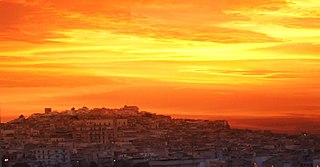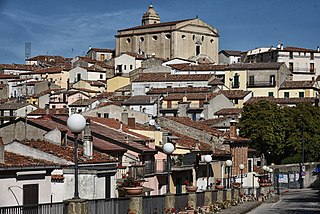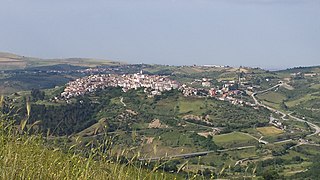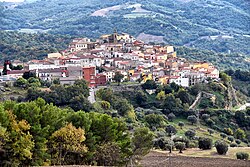
Rimini is a city in the Emilia-Romagna region of Northern Italy.

Canosa di Puglia, generally known simply as Canosa, is a town and comune in the province of Barletta-Andria-Trani, Apulia, southern Italy. It is located between Bari and Foggia, on the northwestern edge of the plateau of the Murgia which dominates the Ofanto valley and the extensive plains of Tavoliere delle Puglie, ranging from Mount Vulture at the Gargano, to the Adriatic coast. Canosa, the Roman Canusium, is considered the principal archaeological center of Apulia, and is one of the oldest continually inhabited cities in Italy. A number of vases and other archaeological finds are located in local museums and private collections. It is not far from the position on the Ofanto River where the Romans found refuge after the defeat of the Battle of Cannae and is the burial place of Bohemund I of Antioch.

Saint Marinus was an Early Christian and the founder of a chapel and monastery in 301 from whose initial community the state of San Marino later grew.

Accettura is a town and comune in the province of Matera, in the Southern Italian region of Basilicata. It is bounded by the comuni of Calciano, Campomaggiore, Cirigliano, Oliveto Lucano, Pietrapertosa, San Mauro Forte and Stigliano.

Ripacandida is a town and comune in the province of Potenza, in the Southern Italian region of Basilicata. It is bounded by the comuni of Atella, Barile, Filiano, Forenza, Ginestra, Rionero in Vulture.

Vaglio Basilicata is a town and comune in the province of Potenza, in the Southern Italian region of Basilicata. It is bounded by the comuni of Albano di Lucania, Brindisi Montagna, Cancellara, Pietragalla, Potenza, Tolve and Tricarico.

Bettona is an ancient town and comune of Italy, in the province of Perugia in central Umbria at the northern edge of the Colli Martani range. It is 5 km (3 mi) E of Torgiano and 12 km (7 mi) SW of Assisi. It is a member of the I Borghi più belli d'Italia association. Passaggio, Colle and Cerreto are frazioni of the comune.

Tolve is a town and comune in the province of Potenza, in the Southern Italian region of Basilicata.

Riccione is a comune in the Province of Rimini, Emilia-Romagna, northern Italy.

Ostra is a town and comune in the Marche, central Italy, near the modern Ostra Vetere, south-east of Senigallia.
Salandra is a town and comune in the province of Matera, in the Southern Italian region of Basilicata.

San Mauro Forte is a town and comune in the province of Matera, in the Southern Italian region of Basilicata.
Stigliano is a town and comune in the province of Matera, in the Basilicata region of southern Italy.

Tricarico is a town and comune in the province of Matera, Basilicata, southern Italy.

Maratea is an Italian town and comune of Basilicata, in the province of Potenza. It is the only comune of the region on the Tyrrhenian coast, and is known as "the Pearl of the Tyrrhenian". Owing to the considerable number of its churches and chapels it has also been described as "the town with 44 churches". It is a member of the I Borghi più belli d'Italia association.

Guardialfiera is a comune (municipality) in the Province of Campobasso in the Italian region Molise, located about 30 kilometres (19 mi) northeast of Campobasso. It sits on a hilltop overlooking Lake Guardialfiera, which was created as a result of the damming of the Biferno river.

San Vincenzo Martire di Craco is a minor saint of the Roman Catholic Church. He is remembered in devotions by the people of Craco in the province of Matera, the Basilicata Region, Italy along with immigrants and their descendants from that town who settled in North America. San Vincenzo Martire di Craco's feast day is celebrated on the fourth Sunday of October in Craco, Italy and Manhattan, New York.

Gaudentius of Rimini, also known as Gaudentius of Ephesus, was a bishop of Rimini, who is venerated as a martyred saint in the Catholic Church and Eastern Orthodox Church.

The Arch of Augustus is a gate in the former city wall of Rimini, Italy, in the form of a Roman honorary or triumphal arch. The arch was dedicated to the Emperor Augustus by the Roman Senate in 27 BC and is claimed to be the oldest large Roman arch still surviving. It marked the end of the via Flaminia, which connected the cities of Romagna to Rome, and spans the modern Corso d'Augusto, which led to the beginning of another road, the via Emilia, which ran northwest to Piacenza.
Saint Leo of Montefeltro otherwise Leone of Montefeltro was the first bishop of Montefeltro from 301. He is traditionally held to have been in origin a stonecutter from Dalmatia. He is venerated as a saint by the Roman Catholic church. His feast day is 1 August.




















